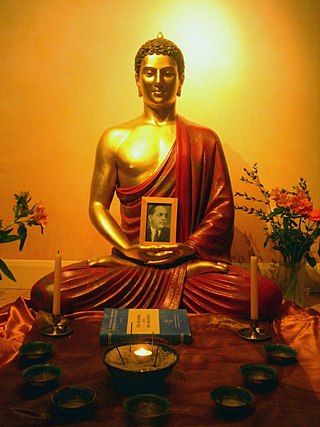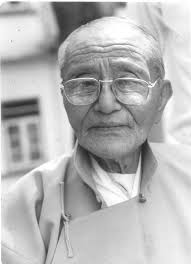
Dennis Philip Edward Lingwood, known more commonly as Sangharakshita, was a British spiritual teacher and writer. In 1967, he founded the Friends of the Western Buddhist Order (FWBO), which was renamed the Triratna Buddhist Community in 2010.

The Triratna Buddhist Community (formerly the Friends of the Western Buddhist Order (FWBO)) is an international fellowship of Buddhists and others who aspire to its path of mindfulness. It was founded by Sangharakshita (born Dennis Philip Edward Lingwood) in the UK in 1967, and describes itself as "an international network dedicated to communicating Buddhist truths in ways appropriate to the modern world". In keeping with Buddhist traditions, it also pays attention to contemporary ideas, particularly drawn from Western philosophy, psychotherapy, and art.

Dhardo Rinpoche (1917-1990), born Thubten Lhundup Legsang, was the 12th in a line of tulkus from Dhartsendo on the eastern border of Tibet who hailed from the Nyingma Gompa in Dhartsendo called Dorje Drak. The 11th tulku rose to the Abbot of Drepung and during the 1912 invasion of Tibet by China was the most senior of the retired abbots in the National Assembly. He died in 1916 and the 12th Tulku was born in 1917.

The Neo Buddhist movement is a religious as well as a socio-political movement among Dalits in India which was started by B. R. Ambedkar. It re-interpreted Buddhism and created a new school of Buddhism called Navayana. The movement has sought to be a socially and politically engaged form of Buddhism.
Engaged Buddhism, also known as socially engaged Buddhism, refers to a Buddhist social movement that emerged in Asia in the 20th century. It is composed of Buddhists who seek to apply Buddhist ethics, insights acquired from meditation practice, and the teachings of the Buddhist dharma to contemporary situations of social, political, environmental, and economic suffering, and injustice.

Subhūti was one of the ten principal disciples of the Buddha. In Theravada Buddhism he is considered the disciple who was foremost in being "worthy of gifts" and "living remote and in peace". In Mahayana Buddhism, he is considered foremost in understanding emptiness.

Deekshabhoomi is a sacred monument of Navayana Buddhism located in Nagpur city in the state of Maharashtra in India; where B. R. Ambedkar with approximately 400,000 of his followers– mainly Dalits, several thousand of whom had been converted to Christianity– embraced Buddhism on Ashoka Vijaya Dashami on 14 October 1956. Ambedkar played a significant role in the revival of Buddhism in India, and inspired many such mass conversions to Buddhism.
Jagdish Kashyap was a Buddhist monk. He was born on 2 May 1908 in Ranchi, Bengal Presidency, India; he died 28 January 1976. The name Kashyap was given to him at his bhikkhu ordination in 1933.
Kalyāṇa-mittatā is a Buddhist concept of "admirable friendship" within Buddhist community life, applicable to both monastic and householder relationships. One involved in such a relationship is known as a "good friend", "virtuous friend", "noble friend" or "admirable friend".
Richard Hayes is an Emeritus professor of Buddhist philosophy at the University of New Mexico. He received his Ph.D. in Sanskrit and Indian studies from the University of Toronto in 1982. Hayes moved to Canada in 1967 in order to avoid being drafted for the Vietnam War.

The Norwich Buddhist Centre (UK) was established in Norwich, Norfolk, England in 1976. The centre is run by people associated with a Buddhist organisation called the Triratna Buddhist Community, previously the Friends of the Western Buddhist Order, founded by Sangharakshita in 1968.

Navayāna, otherwise known as Navayāna Buddhism, refers to the modern re-interpretation of Buddhism founded and developed by the Indian jurist, social reformer, and scholar B. R. Ambedkar; it is otherwise called Neo-Buddhism and Ambedkarite Buddhism.

Kazi Lhendup Dorjee, also spelled Lhendup Dorji or Lhendup Dorji Khangsarpa was an Indian politician who was the 1st chief minister of Sikkim from 1975 to 1979 after its union with India. He was the 1st Prime Minister of Sikkim from 1974 to 1975. He also served as the Executive Council of Sikkim from 1967 to 1970. He was a member of INC after 1975 and Sikkim National Congress before 1975.
Buddhism is a small minority religion in the Netherlands, but it has shown rapid growth in recent years. As of the 2006 estimate, 170,000 Dutch people identified their religion as Buddhist.
Dharmachari Aryadaka (1948–2003), born as Philip Miller in Seattle, Washington, was best known for being the first Buddhist chaplain in Washington state prisons.
The Buddha and His Dhamma, is a 1957 treatise on Buddha's life and philosophy. It was the last work of Indian statesman and scholar B. R. Ambedkar. According to Queen (2015), the text is treated as scripture for those who follow Navayana Buddhism.
Buddhist modernism are new movements based on modern era reinterpretations of Buddhism. David McMahan states that modernism in Buddhism is similar to those found in other religions. The sources of influences have variously been an engagement of Buddhist communities and teachers with the new cultures and methodologies such as "Western monotheism; rationalism and scientific naturalism; and Romantic expressivism". The influence of monotheism has been the internalization of Buddhist gods to make it acceptable in modern Western society, while scientific naturalism and romanticism has influenced the emphasis on current life, empirical defense, reason, psychological and health benefits.
Chen Chien Ming, also known as Yogi C. M. Chen or simply as Yogi Chen, was a Chinese hermit who lived in Kalimpong, India, from 1947 until 1972, when he moved to the United States, where he lived for the remainder of his life.
Susan Kathryn Hookham, known as LamaShenpen Hookham is a Buddhist teacher who has trained for over 50 years in the Mahamudra and Dzogchen traditions of Tibetan Buddhism.
Ian Johnson, known by his Dharma name Maitreyabandhu, is a British Buddhist writer and poet who lives and works at the London Buddhist Centre. He has written a number of books on Buddhism. His poetry has been published by Bloodaxe and awarded the Keats-Shelley Prize and the Geoffrey Dearmer Award.









